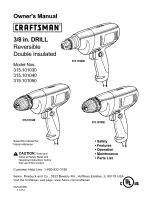
English - 2
■
Use the machine only with the auxiliary
handle 7.
The auxiliary handle 7 can be rotated around the
axis of the machine after loosening the knurled
nut and adapted to the working position in this
manner.
The auxiliary handle 7 can be remounted to suit
left-handed users:
For this purpose, unscrew the knob completely
and then remove the hex-head bolt by pulling up-
ward.
Pull off the auxiliary handle 7 to the side and ro-
tate the remaining clamping part by 180 degrees.
Remount the auxiliary handle 7 in the reverse or-
der.
■
Before any work on the machine itself, pull
the mains plug.
With the SDS-max tool holder, simpler and easier
tool changing is possible without additional aids.
☞
Grease the shank end of the tool regu-
larly.
The dust protection cap 1 largely prevents the
entry of drilling dust during operation. When in-
serting the tool, take care that the dust protection
cap 1 is not damaged.
A damaged dust protection cap should be
changed immediately. We recommend having
this carried out by an after-sales service.
Inserting (see figure
)
Clean and grease the shank end of the tool.
Insert the tool in a twisting manner into the tool
holder until it locks. Check if it has locked by pull-
ing the tool.
Removing (see figure
)
Push back the locking sleeve 2 of the tool holder
and remove the tool. Let go of the locking
sleeve 2 again.
Observe correct mains voltage: The voltage of
the power source must agree with the voltage
specified on the nameplate of the machine.
Equipment marked with 230 V can also be con-
nected to 220 V.
Switching On and Off
For starting operation of the machine, push the
On/Off switch 4 to the right.
For starting operation of the machine, push the
On/Off switch 4 to the left.
☞
At low temperatures, the machine reaches
full impact rate only after a certain time.
This start-up time can be shortened by
striking the chisel against the floor once.
The electronic control makes possible the contin-
uous selection of the impact rate in accordance
with the material to be worked. The setting is
made with impact rate control 5.
The constant electronic control keeps the prese-
lected impact rate nearly constant between no-
load and load conditions.
The speed must be selected in accordance with
the material.
All values are approximate.
Auxiliary Handle
Changing the Tool
A
B
Initial Operation
Changing the Impact Rate
Area of Application Control
Setting
Impact Rate
(bpm)
Plaster/
lightweight materials
1 – 2
950 – 1 180
Removing tiles
3
1 380
Brick
4
1 520
Concrete
5 – 6
1 710 – 1 890
9 • 1 619 929 581 • TMS • 15.04.02










































